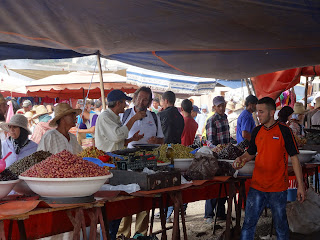Wednesday dawned wet and wetter. The rain that came at 4am went away for only
a couple of hours and returned by 9. We
were not thrilled at the idea of 42 miles in the rain to Al-Jebha, then a raft
up in a harbour alongside a fishing boat in the wet.
Carol did a rethink and suggested we go to Ceuta, only about 15 miles away and with a nice marina. I was convinced so we motored over to the Police and fuel dock and checked out of Morocco.
Off to Ceuta in the rain.
We managed to sail for a while then, as usual when things are going
well, the wind died. And it went on the
nose. Sails in, motor on but with wind
on the nose, and raining, the rain was in my face. I hate rain on my glasses because I can’t see
but there was no other option. Still, it
wasn’t cold so there was some relief in that.
By the time we reached the Ceuta harbour walls the rain had
stopped and we had a sunlit entry past the Hercules statue into Marina
Hercules. We were glad of the change in
weather because there were giant ferries and ships going in all directions, in
and out, and entry was a little hectic.
Then we had to Med-moor for the first time, reversing into a “slip” with
nothing on the side and a mooring rope to hold the bow in place. We managed
that without hitting anything with Carol and Mike doing a sterling job on
fenders and lines. Interestingly, when I
checked into the marina, the marina took our passport information but when I
asked where to go to get them stamped as entering Spain, the lady in the office
said “they could see you when you passed the Port Authority building and if
they’d wanted your passports they would have asked for them by now.” I just love this relaxed attitude to entering
a country.
Once more on this journey a completely unplanned stop has
turned out to be a wonder. This place is
amazing. I think I’d heard of it once
before in my life. The marina is “in”
town. We are slipped just off the main
drag. At one point today, after Mike and
I had managed to change our Dirhams for Euros, we could look one way and see
the Atlantic and turn through another archway 180° and see the
Mediterranean. It is a very swish
Spanish city, with all mod cons, and at the same time a very ancient lived-on
site.
As with mainland Spain, food and wine are inexpensive. A huge meal for 4 of us of 24 steel kebabs
(12 chicken, 12 beef) plus a house salad and a huge mixed grilled fish plate
for Carol set us back €51 and that included a bottle of decent red (El Coto,
the Stag) and a large CruzCampo for me.
Plus complimentary bread and olives.
Great restaurant, Cafeteria Heladeria Gin, Avda Sanchez Prados.
Ceuta is a duty-free city and people come over from Spain and Morocco to
buy luxuries here. I went looking for a
new lens today and came across a Tamron 18-200, which has only recently been
advertised in National Geographic, and got one for €189 or say $A200. Clothes, perfume, electronics all over.
Everywhere you look there are elegant street lamps,
impressive statues and busts of formidable Greek and Roman intellects (Homer,
Aristotle..) Navigators, chart makers.
Public parks and fountains, churches and cathedrals. A delight to be in.
Carol was in McDonalds this afternoon (free wi-fi) and heard
some Australian accents. She went over
to inquire and met 4 Australians who had just spent 3 weeks driving around
Morocco in two cars they’d leased in France. Derick and Beth Johnston and Peter
and Julie Kitchingman, all from Kalamunda, are well-seasoned travelers with
many miles and countries covered. It’s a
small world for sure and to boot Julie knows Jim Chute, who I sailed with in
the early 80s on Challenger.
If you’re ever in Spain, jump on the ferry from Algecira or
Tarifa and come on over to Ceuta for a few days.

























